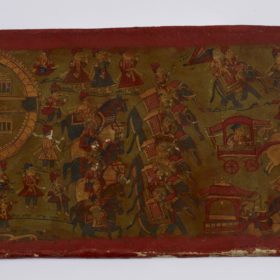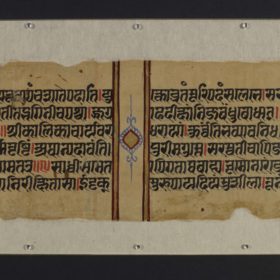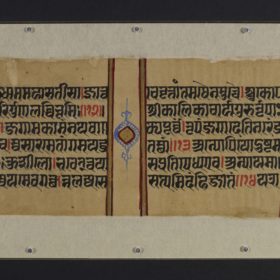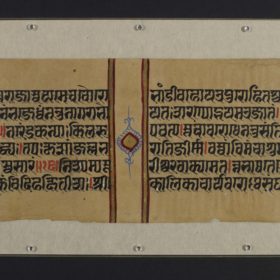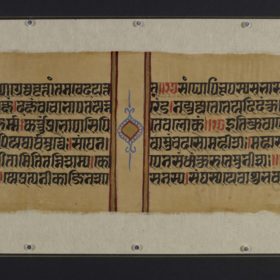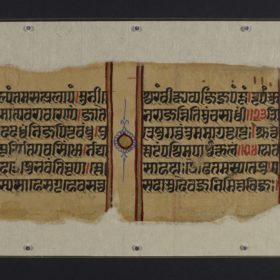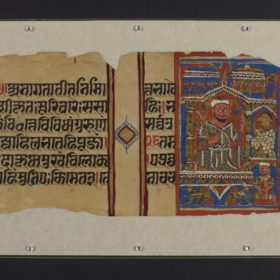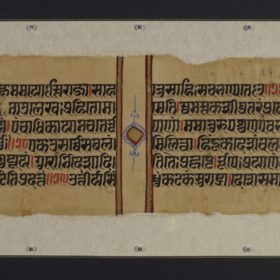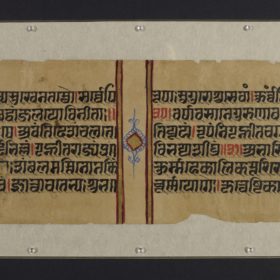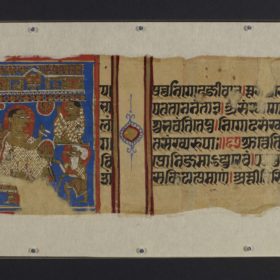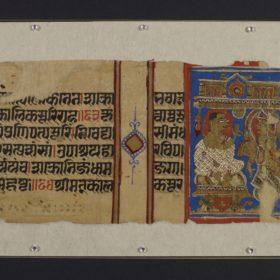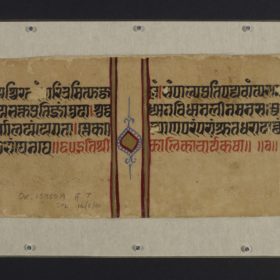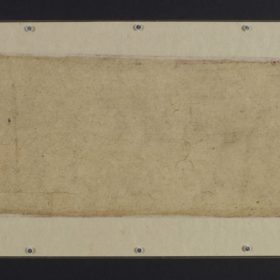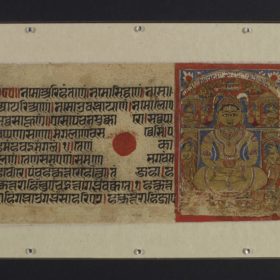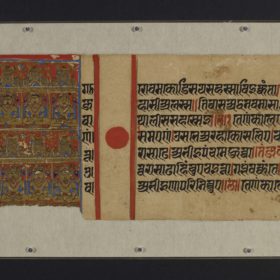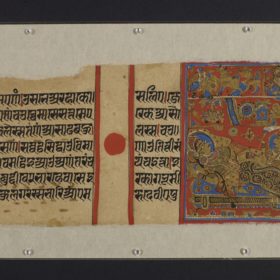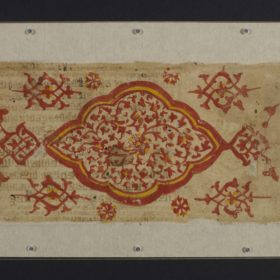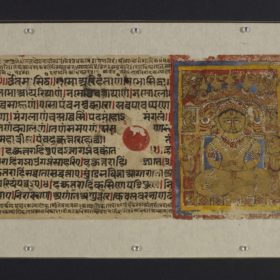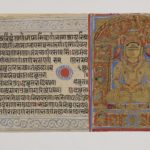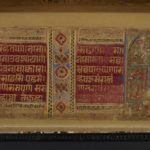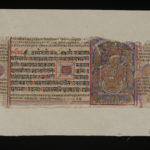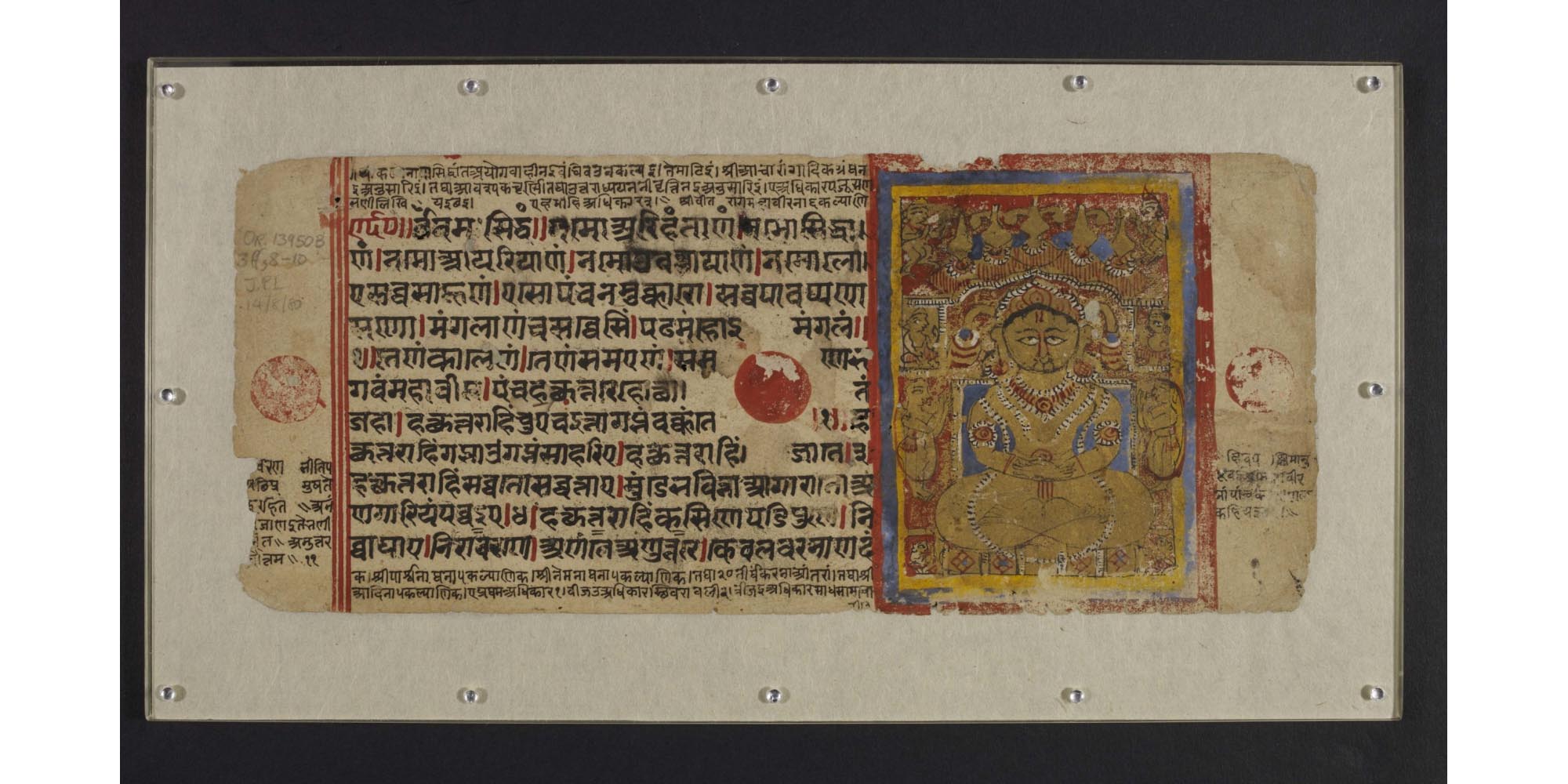
Background
The Kalpa-sūtra is the most frequently illustrated Jain text of the Śvetāmbara sect. It is read and recited by monks in the festival of Paryuṣaṇ, which takes place in August to September each year.
The first part of the Kalpa-sūtra deals with the lives of the Jinas, especially Mahāvīra, Pārśva, Nemi and Ṛṣabha. It features almost identical stories of their births, lives as princes and then their renunciation, enlightenment and emancipation.
The second part – Sthavirāvali – is a praise of the early teachers of Jainism. The third part – Sāmācārī – deals with particular monastic rules to be followed during the rainy season.
Assorted folios
The pages or folios under this shelfmark belong to different manuscripts. The folios show a variety of handwriting, language and artistic style and are on noticeably different paper.
The folios are from four separate manuscripts, as follows:
- several folios are from a single manuscript of the Kālakācārya-kathā – Story of the Ācārya Kālaka
- three folios are from different manuscripts of the Kalpa-sūtra, an extremely popular text in the Śvetāmbara canon.
There is also a manuscript holder made for an unknown manuscript.
It is not known what has happened to the rest of each manuscript.
Copies of the Kalpa-sūtra and Kālakācārya-kathā are often made in a single manuscript, which may be why these folios were bundled together. At some point in the past these folios and the manuscript holder were put into a box at the British Library and labelled ‘Frags. of Jain Mss. Skt. / Pkt.’ meaning 'Fragments of Jain manuscripts in Sanskrit and Prakrit'. However, it is important to remember that they do not belong together.
Transcription
1. //§O// namaḥ siddhaṃ / namo arihantāṇaṃ / namo siddhā-
2. svatī tad-bhaginī ca paścāj jagrahe dīkṣāṃ nija-bandhu-bodhāt //
3. e savva-sāhūṇaṃ / eso paṃca-namukkāro / savva-pāva-ppa-
4. ṇāsaṇo / maṃgalāṇaṃ ca savvesiṃ / paḍhamaṃ havai maṃgalaṃ //
5. teṇaṃ kāleṇaṃ / teṇaṃ samaeṇaṃ / samaṇe bha-
6. gavaṃ Mahāvīre / paṃca hatth’-uttare hotthā / taṃ
7. jahā / hatth’-uttarāhiṃ cue caittā / gabbhaṃ vakkante /1/ ha-
8. tth’-uttarāhiṃ gabbhāo gabbhaṃ sāharie / hatth’uttarāhiṃ jāte /3/
9. hatth’-uttarāhiṃ savvato savvattāe muṇḍe bhavittā agārāto a-
10. ṇagāriyaṃ pavvaie /4/ hatth’-uttarāhiṃ kasiṇe paḍipunne ni-
11. vvāghāe nirāvarāṇe aṇante aṇuttare kevala-vara-nāṇa-daṃ-
Translation
1. //bhale// Homage to the Arhats / Homage to the Siddhas /
2. Homage to the teachers / Homage to the preceptors / Homage to
3. all monks in this world / This is the fivefold homage. Which destroys
4. all sins. Among all auspicious things this is the first auspicious // 1//
5. At that time, in that period, the Venerable Ascetic
6. Mahāvīra had, when the moon was in conjunction with the asterism Uttaraphālgunī, five auspicious events – to
7. wit: in Uttaraphālgunī he descended [from heaven]. After having descended he entered the womb /1/
8. in Uttaraphālgunī he was transferred from one womb to the other, in Uttaraphālgunī he was born /3/.
9. in Uttaraphālgunī totally completely he tore out his hair, left the house
10. and entered the state of houselessness /4/ In Uttaraphālguṇī he obtained the highest knowledge and intuition, called Kevala, complete, perfect
11. unobstructed, unimpeded, infinite, supreme.
Comments
This page, which is the beginning of the text, provides important elements.
Firstly, the fivefold homage – pañca-namaskāra – is a regular opening formula for texts or religious ceremonies. Here it is on lines 1 to 4.
Secondly, astrological matters are significant in the biographies of the Jinas. In the case of Mahāvīra, some of the auspicious events – pañca-kalyāṇakas – that mark the life of a Jina took place under the constellation of Uttaraphālgunī. These are listed together on the first page as:
- descent from heaven
- transfer of the embryo
- birth
- initiation into ascetic life
- attainment of omniscience – kevala-vara-nāṇa-daṃsaṇa – which are the last words on this page.
The last auspicious event is final emancipation, which is not in this list because it took place under a different constellation, namely Svāti.
Śvetāmbara Jains believe that the transfer of the embryo involved only Mahāvīra, the 24th Jina, while Digambaras hold that this episode did not occur with any Jina. Among Śvetāmbaras there are discussions as whether it should be counted among the official kalyāṇakas, which brings the list to six items not five. Monastic leaders of the Kharatara-gaccha have tried to promote this view. They use this passage in their argument as, in their eyes, it shows that the transfer of the embryo is integrated into the whole set of auspicious events.
This page has an addition on line 9 generally not recorded among variant readings. This line states that the Jina tore out his hair ‘totally and completely’. This is an insistence on the fact that tearing out the hair is both material and spiritual. Spiritually, it means having got rid of all desires, passions and so on that hamper the journey to enlightenment and liberation.
Glossary
Description
Bedecked in jewellery, a large figure wearing a kind of tilaka on his forehead sits in the lotus position under an arch. Either side of him are two smaller figures with their hands raised in respect. They are worshippers. The one on the left holds a broom under his armpit. He is probably a monk, shown as a representative of the monastic community. The one on the right could represent the lay community. Other smaller figures are musicians and dancers.
This is the standard representation of a Jina in the heaven where he is reborn before his final incarnation on earth. In that final life on earth, he reaches omniscience and becomes a Jina.
A Jina is always shown in meditation, either standing or sitting, like here. Among the Śvetāmbaras, the Jina is thought of as a spiritual king and is often depicted with ornaments and seated on a throne.
Here the Jina is the 24th, Mahāvīra, whose life is first narrated in the Kalpa-sūtra. He is shown sitting in meditation posture on a throne inside a pavilion. He is flanked by attendants with hands upraised in a gesture of respect.
The long protruding eye is a typical feature of Western Indian painting. Its origin is unclear.
Other visual elements
In this manuscript the script is ordinary, not close to calligraphy, as often happens with manuscripts of the Kalpa-sūtra.
Though quite damaged now, the three red circles along the central horizontal plane are symbolic reminders of the way in which palm-leaf manuscripts were bound. Strings through three holes in the palm leaf were used to thread together the loose folios so the reader could turn them over easily. The circles are in the places where the holes would once have been.
Script
The elaborate script used for the text is the Jaina Devanāgarī script. It is used for writing numerous Indian languages, here for Prakrit. There are a few notable features of this script, which:
- is an old type in the way the sounds e and o are notated when used with a consonant, known as pṛṣṭhamātrā script
- contains red vertical lines within the text marking out verse divisions. Single red vertical lines indicate where a verse is divided in two, while double red vertical lines are found at the end of the verse.
This is the beginning of the text. This is indicated by the:
- red sign at the very beginning of the first line, which is an auspicious sign called bhale
- number 1 in the lower right margin, which is the folio number.
There are marginal annotations written in smaller script, which is Gujarati.
For instance, in the upper margin other works are referred to, such as:
- those in the Śvetāmbara canon, for example the Ācārānga-sūtra
- texts including the Āvaśyaka-cūrṇi and the commentary of the Uttarādhyayana-sūtra.
In the left margin are scattered glosses corresponding to places signalled by ‘=’ in the main text. At the end of the last line in the left margin is the number ‘11’. This refers to the line number of the main text to which the gloss refers.
- Source:
The British Library Board
- Shelfmark:
Or. 13950
- Author:
unknown
- Date of creation:
unknown
- Folio number:
1 verso
- Total number of folios:
10
- Place of creation:
western India
- Language:
various in Devanāgarī script
- Medium:
opaque watercolour on paper
- Size:
25 x 10.5 cms
- Copyright:
CC0 1.0 (Creative Commons Public Domain)
- Image Copyright:
- +
- aAbhavya
- aAbhinandana
- aAbhiṣeka
- aĀcāra
- aĀcārāṅga-sūtra
- aĀcārya
- aAchalbhrata
- aAḍhāī-dvīpa
- aAdharma
- aAdho-loka
- aAdhyayana
- aAdvaita Vedānta
- aĀgama
- aAghātīya
- aAghātīya-karman
- aAgnibhuti
- aAgra
- aĀhāra
- aAhiṃsā
- aAhimsa Day
- aAjita
- aAjīva
- aAkampit
- aĀkāśa
- aAkbar the Great
- aAkṣaya-tṛtīyā
- aAlauddin Khalji
- aAlbert Einstein
- aAllah
- aAlms
- aĀlocanā
- aAloka-ākāśa
- aAmāri
- aAmbikā or Kūṣmāṇḍinī
- aAnagāra
- aAnanta
- aAnarthadaṇḍa
- aAnaśana
- aAnekānta-vāda
- aAṅga
- aAniconism
- aAnojjā
- aAntarāla
- aAntarāya-karma
- aAṇu
- aAṇu-vrata
- aAnukampā
- aAnuprekṣā
- aAnusvāra
- aApabhraṃśa
- aAparigraha
- aAra
- aĀrambha
- aĀrambhaja
- aĀratī
- aArdhamāgadhī Prākrit
- aArhaṃ
- aArhat
- aArśana-āvaraṇīya-karma
- aĀrta-dhyāna
- aĀryikā
- aĀryikā Jñānamati
- aĀśātanā
- aĀścarya
- aAscetic
- aAsceticism
- aAshram
- aAspiration
- aĀsrava
- aAṣṭa-maṅgala
- aAṣṭāpada
- aAstikāya
- aAstrolabe
- aAsura
- aAtheism
- aAticāra
- aAtiśayakṣetra
- aAtithisaṃvibhāgavrata
- aĀtma-vāda
- aĀtman
- aAuṃ
- aAurangzeb
- aAuspicious
- aAusterity
- aAvadhāna
- aAvadhi-jñāna
- aĀvaraṇī-yakarman
- aAvasarpiṇī
- aAvatāra
- aAvidyā
- aAxiom
- aĀyāga-paṭa
- aĀyambil
- aĀyu-karma
- aĀyurveda
- bBabur
- bBāhubali
- bBaladeva
- bBālāvabodha
- bBandha
- bBasadi
- bBazaar
- bBhadrankarvijay
- bBhagavant
- bBhaktāmara-stotra
- bBhakti
- bBhale
- bBharata
- bBhāṣā
- bBhāṣya
- bBhaṭṭāraka
- bBhāva
- bBhāva-pūjā
- bBhāvanā
- bBhavana-vāsin
- bBhavya
- bBhavyatva
- bBhaya
- bBhoga-bhūmi
- bBhogopabhoga
- bBodhi
- bBollywood
- bBrahmā
- bBrahma-deva
- bBrahmacārī
- bBrāhmaṇa
- bBraj Bhāṣā
- bBright fortnight
- bBritish Raj
- bBuddha
- bBuddhi-sagar
- bBuddhism
- bBuddhist
- cCaitya
- cCaityavāsin
- cCakravartin
- cCakreśvarī
- cCāmara
- cCandanā
- cCandragupta
- cCandraprabha
- cCanon
- cCāritra
- cCāritramohanīya-karman
- cCarũrī
- cCaste
- cCaturvidha-saṅgha
- cCaturviṃśati-stava
- cCāturyāma
- cCE
- cCelibacy
- cCha
- cChadmastha
- cChastity
- cCheda-sūtra
- cChristian
- cChristianity
- cClergy
- cCloning
- cColophon
- cCommentary
- cConch
- cConfession
- cCongregation
- cConsecration
- cCosmology
- cCremation
- cCrore
- cCult
- cCūrṇi
- dDādā-guru
- dDalit
- dDāna
- dDaṇḍa
- dDark fortnight
- dDarśana
- dDarśanamohanī-yakarman
- dDaśa-lakṣaṇa-parvan
- dDeity
- dDelhi Sultanate
- dDerāsar
- dDeśāvakāśika-vrata
- dDetachment
- dDevanāgarī
- dDevānandā
- dDevarddhi-gani
- dDevotee
- dDhamal
- dDhanuṣ
- dDhāra
- dDharma
- dDharma-dhyāna
- dDharma-sāgara
- dDharmastikaya
- dDhātakīkhaṇḍa
- dDholak
- dDhyāna
- dDiaspora
- dDig-vrata
- dDigambara
- dDīkṣā
- dDisciple
- dDīvālī
- dDivya-dhvani
- dDNA
- dDoctrine
- dDogma
- dDonor
- dDoṣa
- dDravya
- dDravya-pūjā
- dDrone
- dDuṣamā
- dDuṣamā-duṣamā
- dDuṣamā-suṣamā
- dDveṣa
- dDvīpa
- eEast India Company
- eEightfold Path
- eEkānta-vāda
- eEkendriya
- eElder
- eElders
- eEschatology
- eEtc up to
- fFarmān
- fFast
- fFatehpur Sikri
- fFestival
- fFestschrift
- fFiruz Shah
- fFly-Whisks
- fFolio
- fFour Noble Truths
- gGaccha
- gGaṇa
- gGaṇadhara
- gGanadharavada
- gGaṇeśa
- gGaṇin
- gGarba
- gGarbha
- gGarbha-gṛha
- gGaruḍa
- gGati
- gGene
- gGenomics
- gGhātī-yakarman
- gGhātīya
- gGhaznavid
- gGhiyasuddin Tughlaq
- gGhurid
- gGloss
- gGotra-karma
- gGujarāt
- gGujarati
- gGuṇa
- gGuṇa-sthāna
- gGuṇa-vrata
- gGupti
- gGuru
- gGuruṇī
- hHagiography
- hHajj
- hHaṃsa
- hHaribhadra
- hHariṇaigameṣin
- hHasta
- hHeresy
- hHiṃsā
- hHindi
- hHindu
- hHinduism
- hHīravijaya
- hHoroscope
- hHrīṃ
- hHumayun
- hHymn
- iIconoclasm
- iIconography
- iIdol
- iIndian Independence
- iIndology
- iIndra
- iIndrabhūti Gautama
- iIndriya
- iInitiation
- iIntercession
- iInvocation
- iIQ
- iIslam
- iIslamicate
- iIṣṭadevatā
- iĪśvara
- jJagat
- jJahangir
- jJain
- jJaina Devanāgarī
- jJaina Śaurasenī
- jJaina-dharma
- jJainaśāsana
- jJainness
- jJaisalmer
- jJamāli
- jJambū-dvīpa
- jJames Burgess
- jJanma
- jJanma-kalyāṇa
- jJarā
- jJāti
- jJina
- jJina-āgama
- jJina-bhavana
- jJina-bimba
- jJina-mātā
- jJinacandra-sūri
- jJinadatta
- jJinaprabha
- jJīva
- jJñāna
- jJñāna-āvaraṇīya-karma
- jJñāna-āvarṇiya
- jJñānsundar
- jJyotiṣka
- kKāla
- kKālakācārya-kathā
- kKālidāsa
- kKalpa-sūtra
- kKalpa-vṛkṣa
- kKalyāṇaka
- kKalyanvijay
- kKamaṇḍalu
- kKamaṭha
- kKarma
- kKarma-bhūmi
- kKarma-grantha
- kKarma-prakṛti
- kKarma-vāda
- kKarmon
- kKarnataka
- kKaṣāya
- kKathā
- kKāvya
- kKāya
- kKāyotsarga
- kKeśa-loca
- kKetu
- kKevala-jñāna
- kKevalin
- kKhalji
- kKharatara-gaccha
- kKnowledge
- kKriyā
- kKriyā-vāda
- kKṛṣṇa
- kKṣamā-śramaṇa
- kKṣapakaśreṇi
- kKṣatriya
- kKṣullaka
- kKulakara
- kKundakunda
- kKunthu
- lLabdhi
- lLaity
- lLakh
- lLāñchana
- lLands of Action
- lLaukāntika
- lLavaṇa-samudra
- lLeśyā
- lLiṅga
- lLinguistics
- lLoka
- lLoka-ākāśa
- lLoka-puruṣa
- lLoka-vāda
- lLotus
- lLotus lake
- mMadhya-loka
- mMahā-videha
- mMahā-vrata
- mMahābhārata
- mMahāmastakābhiṣeka
- mMāhārāṣṭra
- mMāhārāṣṭrī Prākrit
- mMahattarā Yākinī
- mMahāvīr Jayantī
- mMahāvīra
- mMakāra
- mMakkhali Gośāla
- mMalli
- mMāna-stambha
- mManaḥ-paryāya-jñāna
- mMaṇḍala
- mMaṇḍapa
- mMandit
- mMaṅgala
- mMantra
- mMantras
- mManuṣya-loka
- mMarāṭhī
- mMārgaṇā
- mMartyr
- mMarudevī
- mMaṭha
- mMati-jñāna
- mMauryaputra
- mMecca
- mMendicant lineage
- mMetarya
- mMiracle
- mMithyādṛṣṭi
- mMohandas Gandhi
- mMohanīya-karma
- mMokṣa
- mMonastic order
- mMonasticism
- mMonk
- mMonotheism
- mMosque
- mMount Meru
- mMount Sammeta
- mMṛgāvatī
- mMughal
- mMuhammad
- mMuhammad bin Tughlaq
- mMuhpattī
- mMūla-sūtra
- mMūlaguṇa
- mMumbaī
- mMuni
- mMunisuvrata
- mMurad Bakhsh
- mMūrti-pūjaka
- mMuslim
- mMysticism
- nNābhi
- nNāga-kal
- nNāgapurīya Tapā-gaccha
- nNāgarī
- nNāma-karma
- nNamaskāra-mantra
- nNami
- nNandīśvara-dvīpa
- nNandivardhana
- nNandyāvarta
- nNāraka
- nNāraki
- nNasalisation
- nNātha
- nNavrātrī
- nNaya-vāda
- nNemi
- nNidāna
- nniggaṃthāṇa vā 2
- nniggaṃtho vā 2
- nNigoda
- nNihnava
- nNikṣepa
- nNirgrantha
- nNirjarā
- nNirvāṇa
- nNiryukti
- nNiṣidhi
- nNitya
- nNiyati
- nNo-kaṣāya
- nNudity
- nNun
- oOcean of milk
- oOmniscience
- oOrdination
- ppa°
- pPadmaprabha
- pPadmāsana
- pPadmāvatī
- pPādukā
- pPalanquin
- pPalette
- pPañca-muṣṭi
- pPāṇḍava
- pPaṇḍit
- pPandit Dalsukh D. Malvania
- pPandit Sukhlalji
- pPāṇipātra
- pPāpa
- pParamātman
- pParameṣṭhin
- pPāraṇā
- pParigraha
- pPariṇāma
- pParīṣaha
- pParokṣa
- pPārśva
- pPārśvanātha
- pParyāya
- pParyuṣaṇ
- pPaṭa
- pPatan
- pPātra
- pPenance
- pPersian
- pPhala
- pPhilology
- pPicchikā
- pPilgrimage
- pPīr
- pPolymath
- pPoṣadha
- pPossession
- pPothī
- pPrabhas
- pPradakṣiṇā
- pPradeśa
- pPrākāra
- pPrakīrṇaka-sūtra
- pPrākrit
- pPramāda
- pPramukhā
- pPrati-vāsudeva
- pPratikramaṇa
- pPratimā
- pPratiṣṭhā
- pPratyākhyāna
- pPratyakṣa
- pPravacana
- pPrāyaścitta
- pPrayer
- pPre-modern
- pPreach
- pPredestination
- pProtestant
- pProvenance
- pPudgala
- pPūjā
- pPujārī
- pPukharavara-dvīpa
- pPuṇya
- pPūrva
- pPuṣkara-dvīpa
- pPuṣpadanta
- pPyre
- qQur’an
- rRāga
- rRāhu
- rRainy season
- rRajasthan
- rRajasthani
- rRājimatī
- rRajoharaṇa
- rRajput
- rRāma
- rRāmāyaṇa
- rRangoli
- rRās-garbā
- rRasa
- rRathanemi
- rRatna-traya
- rRātri-bhojana
- rRaudra-dhyāna
- rRecto
- rRelic
- rRenunciation
- rRetroflex
- rRevatī
- %Ṛg-veda
- rRite
- rRosary
- %Ṛṣabha
- %Ṛṣabhanātha
- rRupee
- sSaciyā Mātā
- sSādhu
- sSādhvī
- sSāgāra
- sSaint
- sŚaivaism
- sŚaka-saṃvat
- sSallekhanā
- sŚalya
- sSamacatuṣṭha
- sSamādhimaraṇa
- sSamaṇi
- sSāmarambha
- sSamavasaraṇa
- sSāmāyika
- sSaṃbhava
- sSamiti
- sSaṃjñā
- sSaṃkalpaja
- sSaṃsāra
- sSamudghāta
- sSaṃvara
- sSaṃvega
- sSamyak-cāritra
- sSamyak-darśana
- sSamyak-jñāna
- sSamyaktva
- sSaṃyama
- sSanctuary
- sSandalwood
- sSaṇgha
- sSanskrit
- sSant
- sŚānti
- sSapta-bhaṅgi-naya
- sSārambha
- sSarasvatī
- sSarvajña
- sSāsan-devi
- sŚāsana-devatā
- sŚāstra
- %Ṣaṭ-jīvanikāya
- sSatī
- sSatīmātā
- sSatya
- sSchism
- sScribe
- sScripture
- sSect
- sSecularism
- sŚenāī
- sSermon
- sŚeṣavatī
- sSevā
- sSeven fields of donation
- sShah Jahan
- sShantidas Jhaveri
- sShrine
- sSiddha
- sSiddha-śilā
- sSiddhacakra or Navadevatā
- sSiddhānta
- sSiddhārtha
- sSiddhi
- sSikh
- sSikhism
- sŚikṣā-vrata
- sŚīla
- sSin
- sSindh
- sŚītala
- sŚiva
- sSkandha
- sSomanatha
- sŚraddhā
- sŚramaṇa
- sŚrāvaka
- sŚrāvakācāra
- sŚrāvikā
- sŚreyāṃsa
- sŚrī
- sŚrīvatsa
- sŚruta-jñāna
- sŚruta-pañcamī
- sSthānaka-vāsin
- sSthāpanācārya
- sSthāvara
- sSthavira
- sSthiti
- sStrīmukti
- sStūpa
- sSubcontinent
- sSudarshana
- sŚuddhi
- sSudharma
- sŚūdra
- sSufism
- sSukha
- sŚukla-dhyāna
- sSulasā
- sSultan
- sSumati
- sSundarśrī
- sSupārśva
- sSūri
- sSuṣamā
- sSuṣamā-duṣamā
- sSuṣamā-suṣamā
- sSūtra
- sSuyam me ausam! Tenam bhagavaya evamakkhayam
- sSvādhyāya
- sSvāhā
- sSvastika
- sŚvetāmbara
- sŚvetāmbara Terāpanthin
- sŚvetāmbaras
- sSwan
- sSyād-vāda
- tTabla
- tTantra
- tTapā-gaccha
- tTapas
- tTāraṇ Svāmī Panth
- tTattva
- tTattvārtha-sūtra
- tTemple
- tTemple-city
- tThe Enlightenment
- tTheology
- tThree worlds
- %Ṭīkā
- tTilaka
- tTīrtha
- tTīrthaṃkaranāma-karman
- tTīrthankara
- tTransliteration
- tTrasa
- tTrasa-nāḍī
- tTriśalā
- tTriṣaṣṭi-śalākā-puruṣa-caritra
- tTti bemi
- tTughlaq
- tTunk
- uUdumbara
- uUniversal History
- uUpādhyāya
- uUpāṅga
- uUpaniṣads
- uUpāsaka
- uUpasarga
- uUpāśraya
- uŪrdhva-loka
- uUtsarpiṇī
- uUttarādhyayana-sūtra
- vVāhana
- vVaimānika
- vVairāgya
- vVaiṣṇava
- vVaiśramaṇa
- vVaiśya
- vValabhī
- vVanaspatikāya
- vVandana
- vVaṇik
- vVarṇa
- vVāsudeva
- vVāsupūjya
- vVayubhūti
- vVeda
- vVedanīya-karma
- vVegetarianism
- vVehicle
- vVernacular
- vVerso
- vVidyā
- vVidyā-devī
- vVihāra
- vVijñapti-patra
- vVikrama-saṃvat
- vVikṛti
- vVimala
- vVinaya
- vVipāka
- vVirji Vora
- vVirodhaja
- vVīrya
- vVisarga
- vViṣṇu
- vVītarāga
- vVizier
- vVotive
- vVow
- vVrata
- vVS
- vVyakta
- vVyantara
- vVyasana
- yYakṣa
- yYakṣī
- yYantra
- yYaśoda
- yYaśovijaya
- yYati
- yYātrā
- yYoga
- yYoginī
- yYojana
Description
Bedecked in jewellery, a large figure wearing a kind of tilaka on his forehead sits in the lotus position under an arch. Either side of him are two smaller figures with their hands raised in respect. They are worshippers. The one on the left holds a broom under his armpit. He is probably a monk, shown as a representative of the monastic community. The one on the right could represent the lay community. Other smaller figures are musicians and dancers.
This is the standard representation of a Jina in the heaven where he is reborn before his final incarnation on earth. In that final life on earth, he reaches omniscience and becomes a Jina.
A Jina is always shown in meditation, either standing or sitting, like here. Among the Śvetāmbaras, the Jina is thought of as a spiritual king and is often depicted with ornaments and seated on a throne.
Here the Jina is the 24th, Mahāvīra, whose life is first narrated in the Kalpa-sūtra. He is shown sitting in meditation posture on a throne inside a pavilion. He is flanked by attendants with hands upraised in a gesture of respect.
The long protruding eye is a typical feature of Western Indian painting. Its origin is unclear.
Other visual elements
In this manuscript the script is ordinary, not close to calligraphy, as often happens with manuscripts of the Kalpa-sūtra.
Though quite damaged now, the three red circles along the central horizontal plane are symbolic reminders of the way in which palm-leaf manuscripts were bound. Strings through three holes in the palm leaf were used to thread together the loose folios so the reader could turn them over easily. The circles are in the places where the holes would once have been.
Script
The elaborate script used for the text is the Jaina Devanāgarī script. It is used for writing numerous Indian languages, here for Prakrit. There are a few notable features of this script, which:
- is an old type in the way the sounds e and o are notated when used with a consonant, known as pṛṣṭhamātrā script
- contains red vertical lines within the text marking out verse divisions. Single red vertical lines indicate where a verse is divided in two, while double red vertical lines are found at the end of the verse.
This is the beginning of the text. This is indicated by the:
- red sign at the very beginning of the first line, which is an auspicious sign called bhale
- number 1 in the lower right margin, which is the folio number.
There are marginal annotations written in smaller script, which is Gujarati.
For instance, in the upper margin other works are referred to, such as:
- those in the Śvetāmbara canon, for example the Ācārānga-sūtra
- texts including the Āvaśyaka-cūrṇi and the commentary of the Uttarādhyayana-sūtra.
In the left margin are scattered glosses corresponding to places signalled by ‘=’ in the main text. At the end of the last line in the left margin is the number ‘11’. This refers to the line number of the main text to which the gloss refers.





























































































